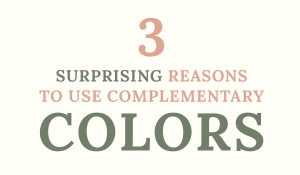Painting with watercolors is often intimidating because it’s very easy to get muddy paintings. But no more after you read this article! I’ll show you how to avoid muddy colors when painting and i’ll show you how to fix a muddy painting. Let’s start!
How to avoid muddy colors when painting
The number 1 reason paintings turn out muddy is because people think they can mix any color with any other color. Yes, it’s all about color theory. But don’t worry, it’s easy to understand!
What are muddy colors?
Muddy colors are colors that look icky. It’s hard to identify what color it is. Instead of being vibrant, muddy colors look dull, boring and dark. They are low in saturation. While it is sometimes what you are going for, when it’s out of context muddy colors will bring down your artwork.

Why does my art look muddy?
The key component to a muddy color is low saturation. Which means it leans more towards gray. We desaturate a color by adding the opposite color on the color wheel (or by simply adding gray).

This means that when our paintings turn out muddy, we’ve mixed colors that desaturated each other too much.
How to avoid muddy colors
We avoid muddy colors by using an optimized palette. A palette’s job is to create any color you need for your painting. You can start with the classic primaries to create every single hue on the color spectrum. Or, you can pick out certain colors that act as primaries. The benefit of this is that you have a limited palette (= less mistakes to make) and the colors are mixed with each other resulting in a cohesive look. I’ll go more in-depth in a future article on how to create such palettes.
Keep Learning
Get weekly articles
Leave your email address below to receive exclusive art content!
The best palette to get the most vivid full range of secondary and tertiary hues is to use a split primary palette. It is a combination of the traditional BYR and CMY color wheel.
The split primary palette creates such vibrant hues because it mixes colors according to the right temperature. Greens are considered cool colors so we use cool primaries to mix them. Oranges are warm colors so we use warm primaries to mix them.
Once you know which temperature your color is, you mix it with the color of the same temperature. This way your colors will be as vivid as can be. The only exceptions are violet and purple.
Mixing complex colors
It gets a little complicated when we use secondaries and tertiaries to mix new colors. We need to know which colors make up those secondaries and tertiaries so we can avoid using one of their complementaries to mix with.
For example a green, a secondary color, exists out of yellow and blue. If we were to mix a purple with a green, for whatever reason, we know that the resulting color will be dull because green has yellow in it. Yellow is the opposite of purple so it will get dulled down resulting in a ‘’’muddy’’ color.
As a rule of thumb:
Don’t mix more than 3 colors. It lowers the chance of getting unwanted muddiness!
It’s better to work with as few pigments as you can to avoid complex situations.
Context is important
The thing is, colors are subjective. They look different in different circumstances. There is a debate on whether muddy colors actually exist. Some artists say muddy colors exist, but others say it depends on the context. Here are some swatches that are considered muddy by some artists.

As you can see, those swatches are swatched from the painting we see above. The swatches on their own might look muddy, but when used in the right context these colors look beautiful.
There's no such thing as muddy colors
When used in the right context, these colors make sense. Think of a nature scene. Nature has a lot of desaturated colors. But it needs contrast by having vivid colors as well. It’s all about finding the right balance.
How to fix a muddy painting
To fix a muddy painting you need to adjust the balance between muddy and vivid colors. Or, simply paint over it. When it comes to certain media like acrylics or oils you can easily paint over it. But when it comes to something more delicate like watercolors you might want to start over. You can always go over it with gouache paint.
Make sure to keep a nice contrast saturation-wise and mix new colors within the same temperature. Keep the number of colors you want to mix as few as possible and think of what other colors they exist out of to avoid mixing with a complementary color. Next time spend a little more on assembling your color palette before diving in.
How to avoid muddy colors in watercolors
Get to know your palette! Swatch all of your colors and then organize them in a way that makes sense to you. I have my colors paired per hue. So the reds are grouped together, as well the oranges, blues, etc. This way I can easily see the difference in temperature. I also wrote down their names and whether it’s a cool or warm color. Since colors are relative, compare them to the rest of your palette and not to the full range of colors that exist.
Now that you know the temperature you can avoid mixing the wrong colors together!
How to avoid muddy colors in Acrylics
Make sure to swatch your colors just like with watercolors. Keep a color wheel near you at all times so you can easily identify a color. Keep your mixtures limited to 2/3 pigments and swatch your mixtures!
How to avoid muddy colors in Digital art
Using a pre-made color script helps you avoid muddiness. You can simply sample those colors and paint away! You can follow my ‘’Color Aesthetic’’ board on Pinterest to get some inspiration. Just make sure to have a saturational balance.
How to avoid muddy colors in oils
The benefit of using oils is that the colors stay wet for a long time. This means you can take your time mixing and preparing a full color palette. Once you have mixed your colors you can start your painting. Not having to mix every single time you need a new color makes painting a lot more fun and stress-free.
Congrats on making it all the way down here! So, are you team ‘’Muddy colors exist’’ or team ‘’Muddy colors don’t exist?’’ I’d love to hear what you think. I personally don’t think muddy colors exist. It’s all about context.
See you next week,
♡ Laura




